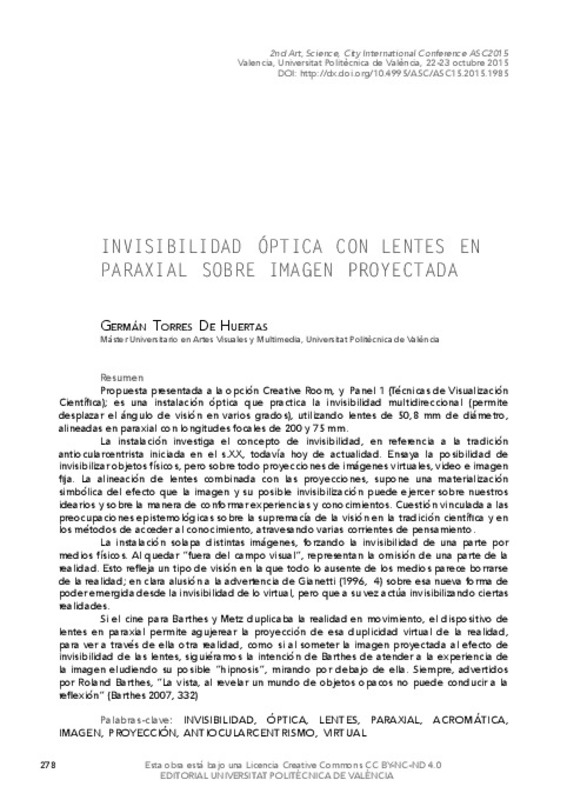|
Resumen:
|
[EN] This is a proposal for the Creative Room option, included in the Panel 1: Techniques for
scientific visualization. It is a installation that practice optical invisibility multidirectional (which
allows you to move ...[+]
[EN] This is a proposal for the Creative Room option, included in the Panel 1: Techniques for
scientific visualization. It is a installation that practice optical invisibility multidirectional (which
allows you to move the angle of vision in several degrees), using lenses and paraxiales acromatics
of 50,8 mm, alienated with focal lengths of 200 mm and of 75 mm.
The installation investigates the concept of invisibility, in reference to the tradition antiocularcentrism
started in the s.XX, still relevant today. Investigates the possibility of reducing,
physical objects, but on all projections of virtual images, video, and stills. The alignment of lenses
combined with projections, assumes a symbolic materialization of the effect that can exert the
image and its possible invisibility on our imaginaries and the way of forming experiences and
knowledge. This question is connected to the epistemological concerns about the supremacy of
vision on the scientific tradition and methods of access to knowledge, crossing several streams
of thought.
The installation combines different images, forcing its invisibility by physical means. To
leave “out of sight” those images, represent the omission of a part of the reality. This reflects a
kind of vision, In which everything absent from media seems to be erased from reality. In allusion
to the warning of Gianetti (1996, 4) on this new form of power emerged from the invisibility of
the virtual, which in addition, it serves treating certain realities.
If the cinema to Barthes and Metz duplicated the reality in motion, the device of paraxials
lenses allows the projection of that duplication of the virtual reality, to see through her another
one, as if when you submit the projected image at the invisibility effect of the lenses, sticking
to the intention of Barthes to respond to the experience of the image being circumvented his
possible “hypnosis”, looking below it.
As if when you submit the projected image at the invisibility effect of the lenses,
chasing the intention of Barthes to respond to the experience of the image evading its possible
“hypnosis”, looking below it.
Always thinking about Barthes: “The sight, on having revealed a world of opaque
objects, he cannot lead to the reflection” (Barthes 2007, 332).
[-]
[ES] Propuesta presentada a la opción Creative Room, y Panel 1 (Técnicas de Visualización
Científica); es una instalación óptica que practica la invisibilidad multidireccional (permite
desplazar el ángulo de visión en ...[+]
[ES] Propuesta presentada a la opción Creative Room, y Panel 1 (Técnicas de Visualización
Científica); es una instalación óptica que practica la invisibilidad multidireccional (permite
desplazar el ángulo de visión en varios grados), utilizando lentes de 50,8 mm de diámetro,
alineadas en paraxial con longitudes focales de 200 y 75 mm.
La instalación investiga el concepto de invisibilidad, en referencia a la tradición
antiocularcentrista iniciada en el s.XX, todavía hoy de actualidad. Ensaya la posibilidad de
invisibilizar objetos físicos, pero sobre todo proyecciones de imágenes virtuales, video e imagen
fija. La alineación de lentes combinada con las proyecciones, supone una materialización
simbólica del efecto que la imagen y su posible invisibilización puede ejercer sobre nuestros
idearios y sobre la manera de conformar experiencias y conocimientos. Cuestión vinculada a las
preocupaciones epistemológicas sobre la supremacía de la visión en la tradición científica y en
los métodos de acceder al conocimiento, atravesando varias corrientes de pensamiento.
La instalación solapa distintas imágenes, forzando la invisibilidad de una parte por
medios físicos. Al quedar “fuera del campo visual”, representan la omisión de una parte de la
realidad. Esto refleja un tipo de visión en la que todo lo ausente de los medios parece borrarse
de la realidad; en clara alusión a la advertencia de Gianetti (1996, 4) sobre esa nueva forma de
poder emergida desde la invisibilidad de lo virtual, pero que a su vez actúa invisibilizando ciertas
realidades.
Si el cine para Barthes y Metz duplicaba la realidad en movimiento, el dispositivo de
lentes en paraxial permite agujerear la proyección de esa duplicidad virtual de la realidad,
para ver a través de ella otra realidad, como si al someter la imagen proyectada al efecto de
invisibilidad de las lentes, siguiéramos la intención de Barthes de atender a la experiencia de
la imagen eludiendo su posible “hipnosis”, mirando por debajo de ella. Siempre, advertidos
por Roland Barthes, “La vista, al revelar un mundo de objetos opacos no puede conducir a la
reflexión” (Barthes 2007, 332)
[-]
|






